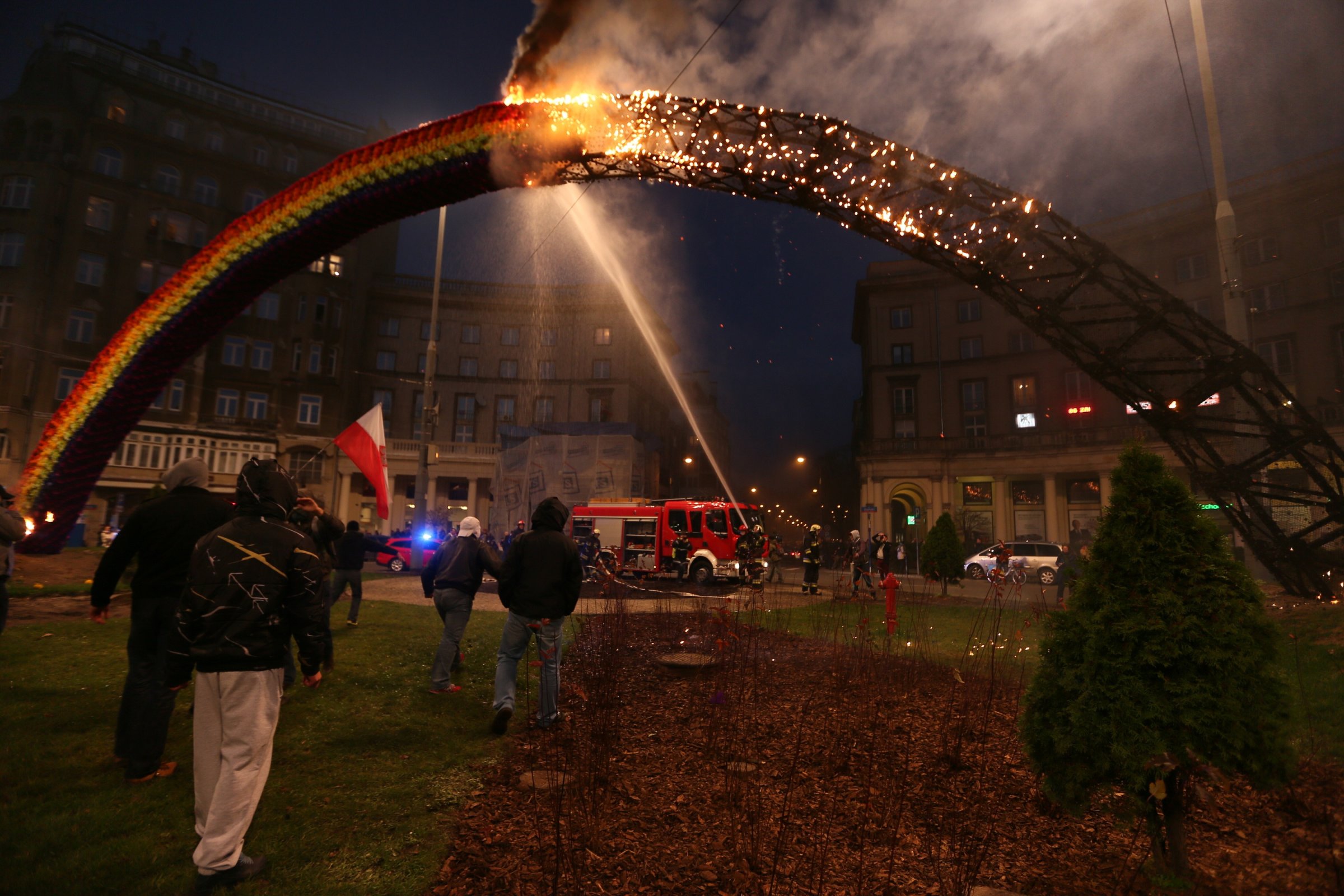
On most days, the rainbow sculpture in Warsaw’s Savior Square stands peacefully — a tangle of wires and plastic, colorful flowers, fashioned into an arch stretching across a traffic circle in front of an old church. The simple structure, burned down six times by nationalist groups decrying its supposed pro-gay symbolism, has been a magnet for controversy and cultural commentary in the three turbulent years that it has stood.
Later this month, it’s being taken down indefinitely, leaving behind a complicated legacy and an uncertain future. Conservative groups campaigning openly against homosexuality have demanded the structure’s permanent removal for years, while the Adam Mickiewicz Institute, the cultural organization that owns it, insists that they are negotiating a new location after their temporary exhibition license expires in the fall.
Poland has in many ways grown more Western and liberal in recent years, embracing a free-market economy and even electing a trans member of Parliament. But experts say that the vocal protests against the rainbow suggest that many Poles are still prejudiced against homosexuality, and, for that matter, anything alien to orthodox Polish culture. More socially liberal citizens worry that the growth of violent nationalist groups, largely responsible for the burning of the statue, is indicative of an overall slide in tolerance in this former Soviet bloc nation of some 40 million people.
Polish sculptress Julita Wojcik, who designed the rainbow sculpture, insists that the installation was initially supposed to carry a multitude of meanings and was not intended as an LGBT symbol. “The colors the rainbow on flags used in the past symbolized a new era, hope, social change, world peace and even, in Poland in the past, cooperation,” she said by email.
Miroslawa Makuchowska, who works for the Polish gay-rights organization Campaign Against Homophobia (KPH), believes the controversy lies in paranoia. “There was a label stuck to [the rainbow] paradoxically by nationalists, right-wing groups and homophobes who only saw it as an LGBT thing,” Makuchowska told TIME.
Groups like the Radical Nationalist Camp, known as ONR, complain of a liberal conspiracy, especially since the rainbow was placed in front of the Church of the Holiest Savior.
“In recent years in Poland, the marginal community of [homosexual] perverts has intensified its war on tradition, symbolism, history and national unity. The rainbow is the best example of this,” Alek Krejckant, a representative of ONR, told TIME via Facebook. “It’s a shame the decision to take it down took so long. This kind of installation belongs in the garbage.”
Makuchowska believes the uproar over the statue is symptomatic of a society that still has deep ties to a conservative Catholic Church. (Poland is often referred to as Europe’s most religious nation; 87.5% of respondents identified as Catholic in a 2011 poll.)
Although Warsaw’s Catholic Archdiocese told TIME it has taken no stance on the structure or its removal, the Catholic Church’s teachings, prominent in Poland’s public school system, still largely portray homosexuality as being something “abnormal,” Makuchowska says.
As politicians with closer ties to the Catholic Church gain power with the support of nationalist groups, some worry that this system will remain strong, and that intolerance toward immigrants, homosexuals and foreign nationals will grow.
“If the conservative [Law and Justice Party] wins the upcoming October elections, things will be more complicated for Poland’s gay population,” Filip Pazderski, a project coordinator and analyst at the Institute of Public Affairs, told TIME.
Magdalena Lan, a PR officer for the city of Warsaw, says that the rainbow’s dismantling is a standard procedure and is not politically motivated, as it was always supposed to be a temporary installation. Pawel Potoroczyn, the director of the Adam Mickiewicz Institute, says that negotiations are ongoing about the statue’s relocation and that his organization remains unfazed by the surrounding controversy. The Adam Mickiewicz Institute has even started an online voting system to ask city dwellers where they want to see the statue reinstalled.
So far, discussions have been ongoing with the Centre for Contemporary Art at the Ujazdowski Castle, according to local media. There are hopes that the castle, located in the center of the former royal gardens, would be a far less controversial spot, especially since the rainbow would no longer be in front of a church. Piotr Guzial, the mayor of Ursynow, a neighborhood of Warsaw, has also publicly expressed interest in adopting the statue in his part of the city.
Potoroczyn hasn’t ruled out that the statue will be reinstalled in Savior Square, either, saying that it’s up to the city to decide. For now, controversy aside, the statue will be renovated and restored over the next few months as its relocation continues to be discussed. “It’s not that the rainbow will be taken down,” Potoroczyn says. “It’s just going away for a bit.”
More Must-Reads from TIME
- Why Biden Dropped Out
- Ukraine’s Plan to Survive Trump
- The Rise of a New Kind of Parenting Guru
- The Chaos and Commotion of the RNC in Photos
- Why We All Have a Stake in Twisters’ Success
- 8 Eating Habits That Actually Improve Your Sleep
- Welcome to the Noah Lyles Olympics
- Get Our Paris Olympics Newsletter in Your Inbox
Contact us at letters@time.com